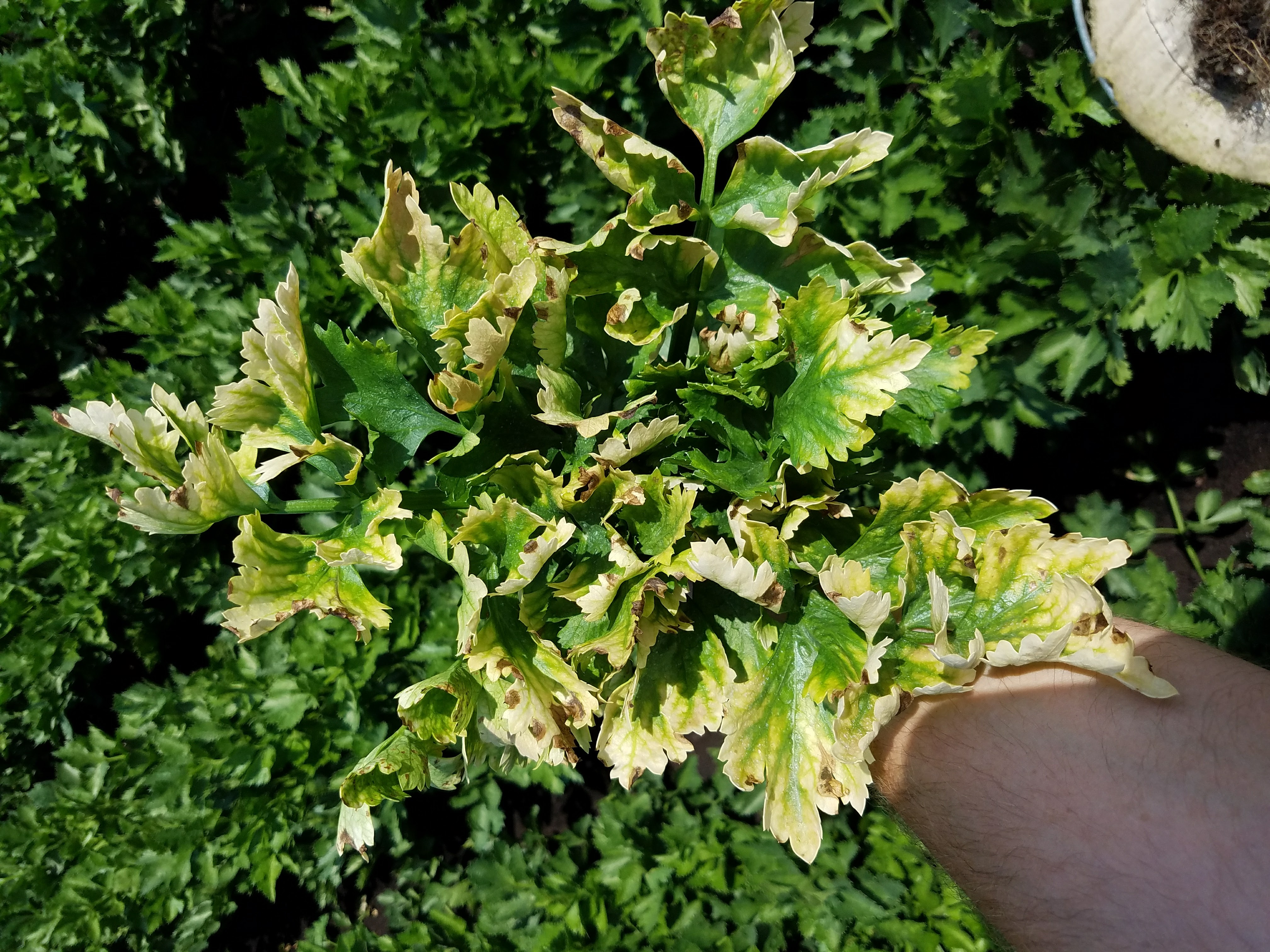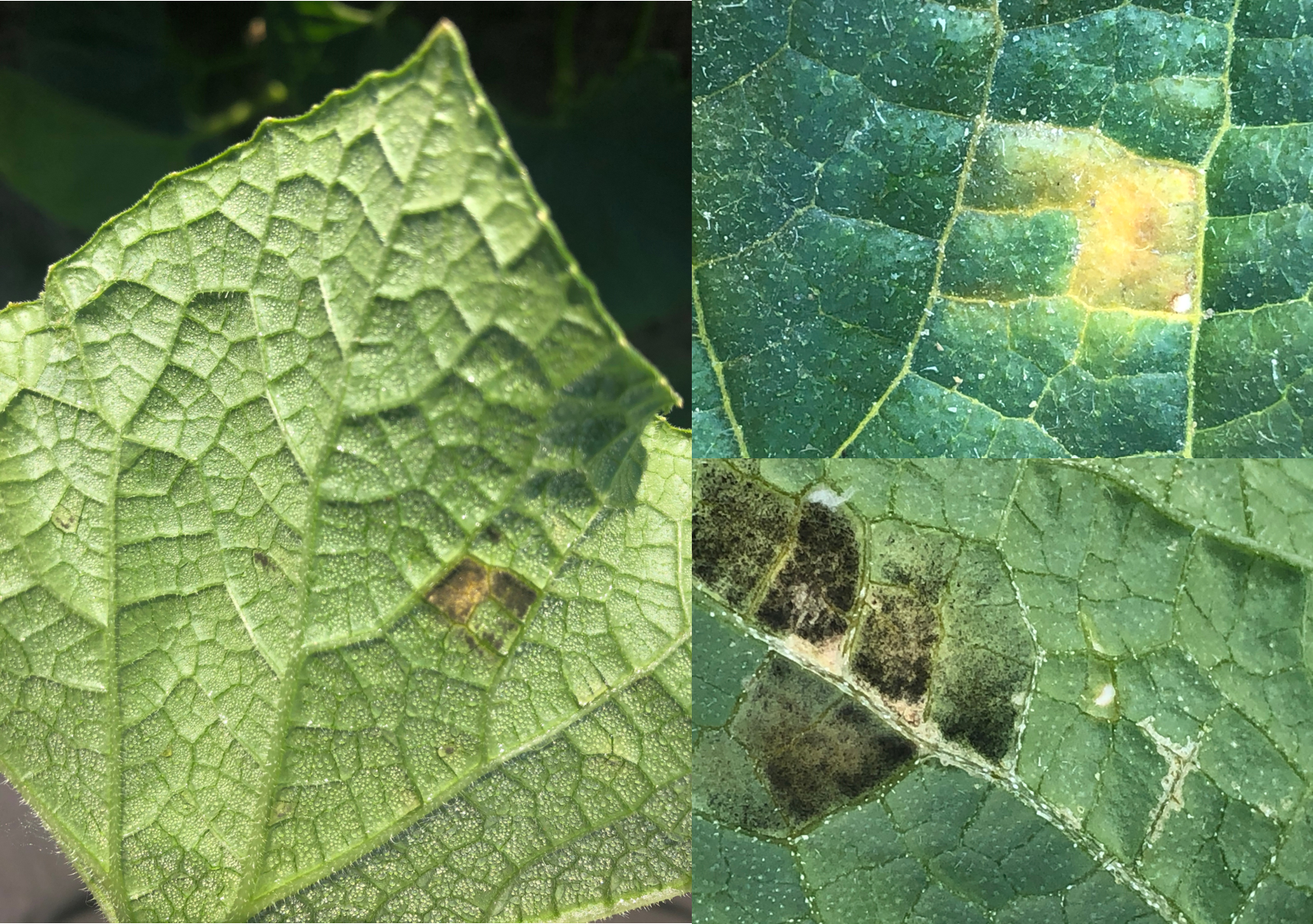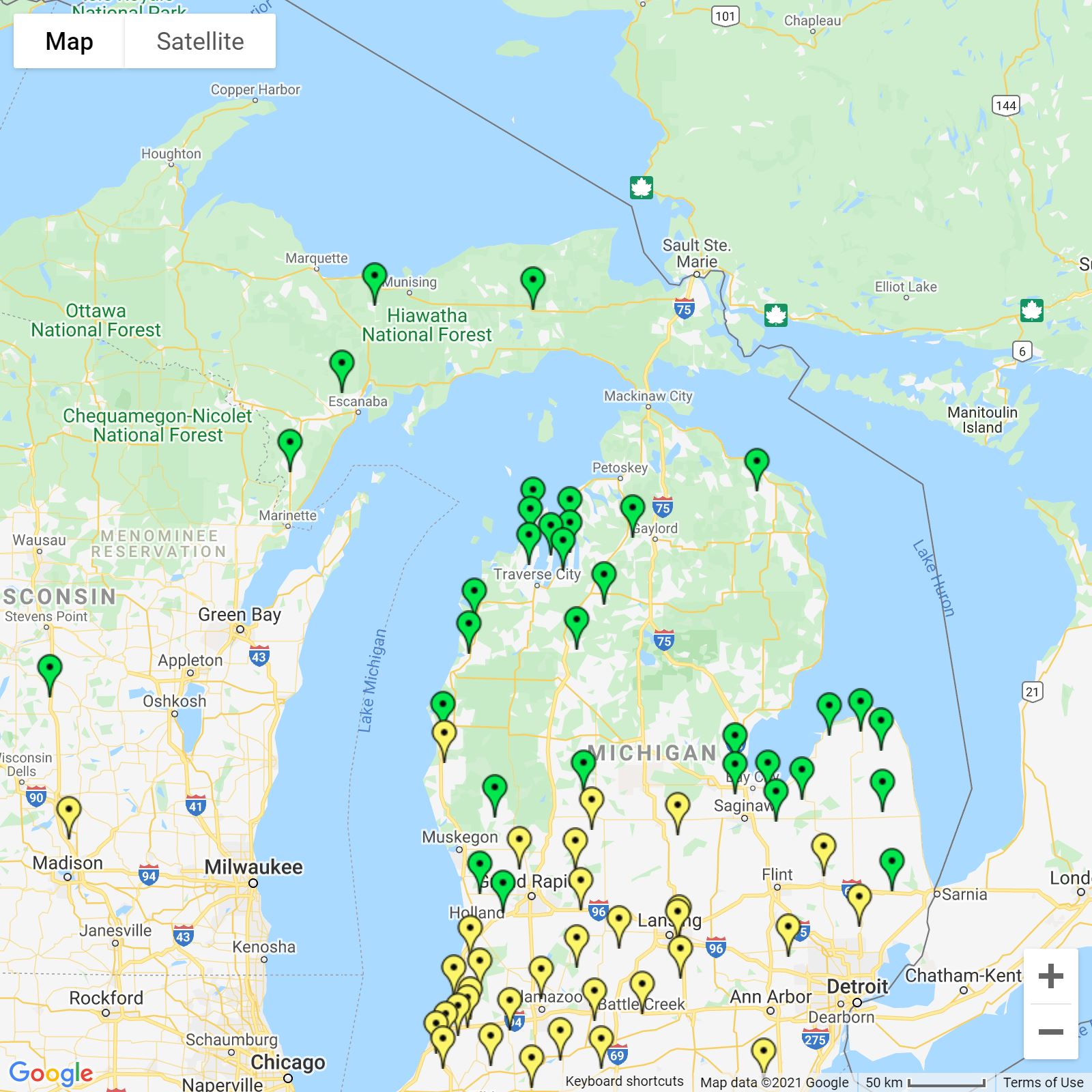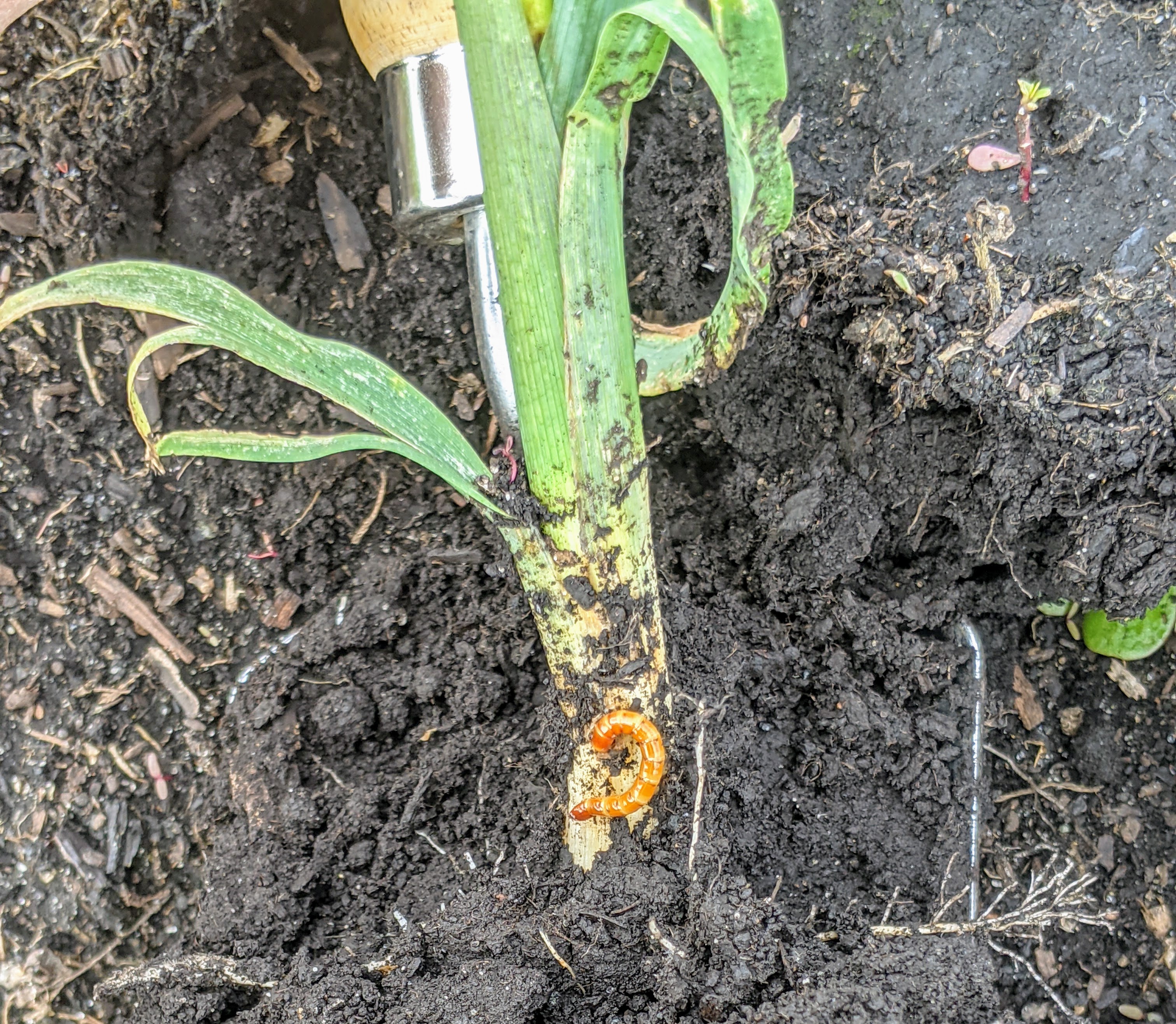Michigan vegetable crop report – June 23, 2021
A prolonged period of precipitation is in the forecast for next week, which could slow planting progress and field management processes.

Weather
Southern lower Michigan experienced severe weather this past Sunday with damaging winds and hail. Rainfall totals were higher this past week, especially over the I-94 corridor, the most precipitation for a week during 2021. Most of the northern lower remained dryer. Average temperatures were slightly cooler than normal for the past week. The area in severe drought expanded to 30% of the state by mid-week last week, including a swath from southwest Michigan across to the Thumb and the northwestern lower.
Soil moisture made some gains in the southern lower with recent heavy rains but declined in the northern half. The rain that is coming will help but will not eliminate our deficit.
Watch Jeff Andresen’s forecast here. The forecast calls for:
- A mostly cloudy Wednesday with scattered showers possible.
- A warmer Thursday, with showers and thunderstorms developing and spreading west to east across the state late Thursday and early Friday and continuing through Saturday. This will likely include several precipitation events and prolonged periods of leaf wetness with heavy rainfall totals possible in many areas (1-3 inches or more).
- Continuing rain threats on a daily basis Sunday into early next week.
- Maximum temperatures warming from the low to mid-70s Wednesday into the 80s Thursday, falling back to the 70s to near 80 Friday and continuing into early next week. Minimum temperatures in the 50s to 60s.
- Medium range guidance suggests a return of warmer than normal weather by early July.
MSU’s network of over 100 weather stations can be accessed at MSU Enviroweather
There are several pest prediction models based on temperature accumulations at the new Enviroweather website: seed corn maggot, cabbage maggot, asparagus miner, European corn borer and squash vine borer. Click on any of those pests to be taken to the model. Once there, change the Station to the one nearest you.
General crop management notes
Precipitation preparedness
With a prolonged period of rain in the forecast, we thought it would be good to cover a few things related to spraying and fertilizing around rain events.
For mechanical cultivation, a little bit of moisture is good for working through any soil crusts that might exist. But too much moisture makes for poor soil movement through the tool, and weeds can recover faster afterwards. Additionally, with any equipment, compaction and degradation of soil structure can follow cultivation in wet soils, especially tools with deeper action. With increasing soil moisture, a shallower tool would be more effective without as many negative effects on soil structure.
How long do postemergence herbicides need to dry before rainfall? Postemergence weed control with herbicides is still possible with a window of drying time before rains or between rains. Here is a table showing rain free periods for postemergence herbicides from the Michigan State University Extension E0433, “Weed Control Guide for Vegetable Crops.”
As it comes to disease prevention, Dan Egel, from Purdue University wrote this article, “Fungicide Applications During Rainy Weather,” which summarizes the timing and rainfastness attributes of several types of vegetable fungicides. He writes, “As a general rule, apply contact products 24 hours before a rain if possible, but an application of a protectant even eight hours before a rain may be effective. Apply systemics one to two hours before a rain. Some product labels have specific information.”
Which products are systemic, and which are contact? That is not always obvious either, and Purdue has another publication summarizing that too, titled “Fungicide Mobility for Nursery, Greenhouse, and Landscape Professionals.” One important note: There is good reason to have fungicides applied prior to an extended period of rain, as leaf wetness is necessary for infection in many pathogens.
For insects, John Wise at MSU wrote this article, “Rainfast characteristics of insecticides on fruit,” which has a lot of crossover products with vegetables. He writes, “For most insecticides, a drying time of two to six hours is sufficient to ‘set’ the compound in or on the plant. With neonicotinoids, for which plant penetration is important, drying time can significantly influence rainfastness. For neonicotinoids, up to 24 hours is needed for optimal plant penetration, thus the time proximity of precipitation after application should be considered carefully. Spray adjuvants, materials intended to aid the retention, penetration or spread on the plant, can also improve the performance of insecticides.” A handy reference for the contact or systemic nature of different insecticides is also included in his article.
For additional nitrogen applications with rain in the forecast, topdressing within a few days before a good rain (about 0.5 inches or more) is the ideal situation, serving to incorporate fertilizer into the soil, washing errant prills off leaf surfaces, and reducing potential for volatilization losses from urea-containing fertilizers.
However, particularly heavy rains can bring concerns about nitrogen losses. How much rain is too much from this standpoint? It depends on a number of factors, including soil texture, soil moisture content, crop rooting depth, and rainfall intensity.
As a general rule though, rain exceeding 3 inches in three days or 4 inches in seven days has the potential to lead to meaningful nitrogen leaching losses. Granted, on heavier textured soils that can hold more moisture, even higher precipitation amounts may be required before substantial nitrogen is moved below the root zone. Keep in mind though that soil and fertilizer nitrogen can also be lost through runoff/erosion at high rainfall intensities or through denitrification if soils remain too wet or flooded for extended periods.
Forecasts (especially of precipitation amounts) can be fickle, so don’t stray too far from recommended topdress timings or rates for your crop based on how much rain might fall. In general, you should only consider making an additional supplemental application of nitrogen (about 30-40 pounds nitrogen per acre) when both significant rainfall meeting the above criteria has occurred and signs of crop nutritional status in the following week (slowed growth, yellowing older leaves) support doing so.
Paraquat
After one of our recent reports, we’ve gotten questions about Gramoxone (paraquat). A law was passed that requires an additional training every three years on top of the basic RUP certification. You don’t need this training to buy the product, but you do need the training to legally use it.
So, are there alternatives to paraquat? There are a few. Pelargonic acid or ammonium nonanoate products such as Scythe and AXXE, and carfentrazone products such as Aim. These products may not provide a similar level of weed control compared to paraquat.
Scythe and AXXE is a non-selective herbicide that can be applied in a 3 to 10% v/v solution in 75 to 200 gallon per acre water for burndown purposes, row-middle treatments at edges of plastic with a hooded sprayer, and strawberry sucker control. Use the lower rate in the rate range for young, succulent and actively growing weeds and the higher rate for weeds greater than six inches in height or in the flowering stage. For strawberry sucker control use at least 5 to 7% v/v solution.
Aim is only effective for broadleaves and does not control grasses. Aim should be used at 0.5 to 2 fl oz per ac for burndown purposes, and row-middle treatments at edges of plastic with a hooded sprayer. The addition of non-ionic surfactant (0.25% v/v) or crop-oil-concentrate (1-2 % v/v) improves the efficacy of Aim. Strawberry sucker control is not on the label.
Crop updates
Asparagus
The last asparagus fields should be shut down by the end of this week as things wrap up in west central Michigan after a challenging year.
The upcoming weather pattern could be favorable for foliar disease development. Frequent rains could result in extended periods of leaf wetness at a time when temperatures are warmer. Don’t forget to keep young fields covered with a protectant such as chlorothalonil or mancozeb, with tebuconazole added if rust is a concern.
As you finish spreading your postharvest fertilizer, consider that recent and past research in Michigan has shown no benefit of applying a season total nitrogen of over 80 pounds per acre in established fields. Postharvest is when plants take up the most nitrogen from fertilizer applications, so it is a good time to “feed the fern.” Nitrogen is most important in young fields that are building their root system, so up to 100 pounds nitrogen per acre are recommended in the establishment year. Older fields are very efficient at scavenging and recycling nitrogen, and needs are relatively low compared to most crops.
Past research by MSU showed that Millenium does respond to irrigation during dry fern seasons, with an average yield boost of 9% the following year. In MSU trials, the majority of water use by MIllenium was in the top 1-1.5 feet of soil. This could be a good year to consider irrigating fern, as we may be starting the fern season dry. Hopefully, upcoming rains will help.
Carrots and celery
Be on the lookout for aster yellows symptoms in carrots this year. Symptoms include bronzing as well as distorted new growth (see photo at start of article).
Scouts detected celery showing aster yellows symptoms this week in west Michigan, the first time in a number of years symptoms have been visible. Leafhoppers continue to be present. Tarnished plant bug is present as well, but continues to be at lower densities than last year. Keep an eye out for aphids on field edges as the season progresses.

Please contact MSU entomologist Zsofia Szendrei at szendrei@msu.edu if you would like to receive real-time text alerts. If you would like to be removed from the text blast, you can text STOP. The latest information is also below.
|
Aster leafhopper infectivity and treatment thresholds for the latest samples processed by the MSU Vegetable Entomology lab. | ||||
|---|---|---|---|---|
|
County |
Date |
Infectivity |
Treatment threshold (leafhoppers per 100 sweeps) | |
|
Celery |
Carrots | |||
|
Van Buren |
6/21 |
0% |
- |
- |
|
Allegan |
6/21 |
5% |
7 |
10 |
Cole crops
Broccoli, cabbage, cauliflower harvest has been regular as far back as four weeks ago for some farms, and just now picking up on other farms. Fall cole crop transplant trays are waiting on wagons under the shade of trees on some farms.
The dust may be settling for cabbage maggot control successes and failures from earlier this year. This pest is typically worst in early-season plantings for most transplanted brassicas but can be a season-long battle in root crops. What else is out there besides chlorpyrifos? Tray drenches with Verimark have consistently reduced damage in trials at Cornell University, and are one option. Postplant, directed applications of spinosad (Entrust) or spinetoram (Radiant) could provide additional control. For rooting brassicas, applications of Mustang Maxx-made weekly during the period flies are active-consistently reduced damage in Michigan State University Trials. Learn more by watching the Vegetable Root Crop Virtual Field Day video.
Cucurbits
Pumpkin plantings continue. The earliest processing pickle plantings are getting close to tip-over. Early protected melons and watermelons have set fruit. Zucchini and yellow squash harvest is going strong on some farms.
Squash bug eggs were being laid this week in some locations. Prior to flowering, if squash bugs are present and plants are wilting, treatment could be justified. The tiny nymphs that hatch from eggs are easiest to control.
Ontario is experiencing field outbreaks of cucurbit downy mildew in cucumber. Experience has taught us that once cucurbit downy mildew develops in Ontario, a Michigan outbreak is not far behind. The timing of this Ontario confirmation seems spot on. There have been several years, when the first field outbreak of downy mildew in Michigan occurred around the first week of July, which is just around the corner. We have recorded two instances of cucurbit downy mildew spores in the air in Michigan using our spore trapping network. This is our first indication that we are seeing an influx of cucurbit downy mildew sporangia into the state, which often occurs a few days or a couple of weeks prior to a field outbreak.
The recent cooler weather and scattered showers are favorable for the transport of downy mildew sporangia in the air and crop infection. The cucurbit downy mildew pathogen does not overwinter in northern growing regions; the spores move from overwintering sites such as production greenhouses or the southern U.S. production regions via air currents. Go to the MSU Downy Mildew News website for Michigan spore trap results and current downy mildew news.

It is very important that cucumber growers use a proven downy mildew program with fungicides shown to have the most consistent and reliable activity in our yearly Michigan research plots including:
- Ranman + chlorothalonil or mancozeb
- Orondis Opti (chlorothalonil is part of the premix)
- Zampro + chlorothalonil or mancozeb
Onions and garlic
Overall, the upcoming week’s weather will elevate the importance of disease control, with extended periods of leaf wetness possible. It will be important to protect foliage ahead of this weather.
FRAC groups 7 and 3 have activity against Stemphylium leaf blight, with the SDHI fungicides (FRAC 7) the clear standout in MSU trials. Single-site modes of action like these can be at risk of resistance development, in contrast to “multi-site” protectants such as chlorothalonil. So how can we use them and (hopefully) not lose them?
Using the “good stuff” up front is important for both maximum plant protection and reducing the risk of pathogen resistance developing. Here’s an analogy: Imagine a millionaire with little to lose, and a deck of cards, will pay out a big cash prize if you draw four aces. They offer you a choice: You can draw four cards or eight. It’s a no-brainer, take eight! It’s the same with resistance development. If you use a good mode of action when pathogen populations are low, there’s a reduced probability that the “winning combination” of fungicide resistance genes will be present. But if you wait until symptoms are visible and pathogen levels are high, you’ve given the pathogen more chances to take random draws from the genetic card deck.
Using a tank mix of a multi-site fungicide such as chlorothalonil (Bravo is an example) with a single-site product has long been used to reduce the risk of fungicide resistance. Both Luna Tranquility (FRAC 7/9) and Miravis Prime (FRAC 7/12) are pre-mixes of two modes of action, so no additions may be necessary. If you use something like Tilt (FRAC 3), consider adding chlorothalonil.
MSU research trials clearly show that using the most effective fungicides early in the production season and at the beginning of a spray program reaps important benefits in the protection of the foliage from Stemphylium leaf blight resulting in increased bulb size and yields. Once the disease becomes established, playing catch up doesn’t seem possible based on our 2020 field studies.
Thrips have been more abundant this year than in other recent years. Onion thrips continue to be present, and in some cases growers may consider applying an insecticide the week after Movento. Scouting will be helpful given the upcoming rain. Agri-Mek can be applied if populations are at 0.8 to one per leaf. Minecto Pro can be applied if populations are a bit higher at one to two per leaf. Radiant can be used if populations are very high at greater than three per leaf.
Potatoes
The Late Blight Forecast is at medium risk for most of the southern lower peninsula. Fungicide programs have been initiated for earlier-planted potato crops near or at canopy closure. At this time, no late blight has been reported anywhere in the U.S. For more information, please visit our MSU Potato and Sugar Beet Pathology website.

Root crops
In the last one to two weeks, weather in the sugar beet growing region has been favorable for Cercospora leaf spot development. Early planted crops are beginning to apply protectant fungicides as part of their foliar management program. According to BEETcast (Weather INnovations), disease severity values (corresponding to weather conditions favoring C. beticola infection) were elevated June 8-9 and again June 19-21 in certain growing areas.
In 2020, Cercospora leaf spot levels were low until later in the season. This year, however, we could expect earlier Cercospora leaf spot onset in areas experiencing periods of elevated risk and a history of disease. Watch the recording of an update on Cercospora leaf spot in sugarbeets via the Field Crops Virtual Breakfast series. Growers with table beet and Swiss chard should be scouting for signs of disease development.
Strawberries
Strawberry pickings are almost done and the prolonged rains in the forecast will certainly reduce you-pick traffic and fruit quality and finish out the June-bearing season.
High levels of twospotted spider mites were observed on several day-neutral greenhouse strawberry plant samples submitted to the MSU Plant & Pest Diagnostics laboratory. See the tomato section below for some general guidelines on biological control options. Many of the same insecticide/acaricide products are available, but refer to the MSU E0154 Michigan Fruit Management Guide or page 172-184 of the Midwest Fruit Guide (free PDF) to be sure.
Sweet corn
Sweet corn plantings continue. Instances of possible fertilizer burn have been observed in a few fields. Risk of fertilizer injury from starter fertilizers increases with higher fertilizer rates, closer proximity to the seed, drier soils, and coarser soil textures (lower CEC). Sometimes these factors come together to conspire against you under management practices that have otherwise been successful in the past. While these symptoms can be caused by other issues as well, first indications of fertilizer injury generally involve an uneven stand (some plants missing or stunted, others fine). Digging up the stunted plants often shows signs of root injury: for example, missing the radicle root entirely or brown/black root tips.
Early sweet corn that had been under cover was just starting to silk at one west Michigan location. In general, it is a good time to get out your corn earworm traps and get them running. Watch videos on how to do this. Insectforecast.com suggests there could be a low risk of isolated flights of corn earworm this Thursday/Friday.
Wireworms are a very sporadic pest of corn. They are the larvae of click beetles and can bore into the plant underground, causing them to wilt. Unfortunately, there is not much that can be done after plants are in the ground, though there are at-plant options. Rotation is a key risk factor: following a root or tuber crop, or following a weedy, grassy field or hayfield, elevates risk.

Some farms may use Bt-traited corn, but which traits help with corn earworm? Vip3A is the only protein that does not have documented resistance at this point. The Handy Bt Trait Table for Sweet Corn shows that the Attribute II and Attribute Plus varieties from Syngenta contain Vip3A. Think of the traits as built-in insecticides. If you use the same insecticide all over all the time, bugs will become resistant to it. Corn earworm/cotton bollworm has been exposed to Cry1Ab and Cry1A105 and Cry2Ab2 Bt proteins from Bt cotton and field corn varieties on much higher acreages around the country and can munch through Bt sweet corn with those proteins as well.
Tomatoes, peppers and eggplants
This week, peppers were going in on white plastic in Macomb County, and more tomatoes are slated for transplant in Oakland County in the next week. Early field plantings of both peppers and tomatoes have small green fruit.
In the hoophouses, tomato leaf mold is starting to show up, along with thrips and mites. The thrips and mite populations were small and isolated, but they can grow fast. That is a good time for using biological controls. Biological controls of plant mites include the predatory mites Amblyseius swirskii, Neoseiulus cucumeris and Stratiolaelaps scimitus, minute pirate bug Orius spp. and beneficial nematode Steinernema feltiae. For thrips, biological controls include some different predatory mites Amblyseius andersonii, Amblyseius californicus, Amblyseius fallacis, Galendromus occidentalis and Phytoseiulus persimilis. Also consider co-releasing a flying predator such as the predatory midge Feltiella acarisuga, and lady beetle Stethorus punctillum.
For sprays, in this situation with both mites and thrips on plants it is not worth spraying with anything that is a broad spectrum insecticide. You end up killing the beneficials and causing delayed flare-ups of mites and thrips that way. That also means controlling the mites first before the thrips, with an effective acaricide. The Midwest Vegetable Guide online database can be filtered to only show products that can be used in the greenhouse, and here are the results for thrips and mites on tomatoes in greenhouses. Agri-mek is effective on both mites and thrips, but it is a RUP with a seven-day PHI. Other acaricides, like Oberon and Kanemite have one-day PHIs, and Acramite has a three-day PHI.
Events
- June 28, 12-1 p.m. - Agritourism Webinar Series: Emerging Issues in Agritourism
- June 30, 12:30-1 p.m. - The Vegetable Beet: Ugh bugs! organic cucumber beetle control (1 RUP for live listeners, also available for later listens as a podcast)
Food safety
Need your water tested for the Food Safety Modernization Act (FSMA)? Check out the Michigan Ag Water Lab Map.
On-Farm Readiness Reviews are designed to help fresh produce growers feel prepared and ready for a full implementation of the Food Safety Modernization Act (FSMA). They allow growers to walk through their operation with a small team of food-safety experts and discuss how to meet the new FSMA Produce Safety Rule requirements. Go here to sign up for one.
Farm Supervisor Produce Safety Courses are being hosted through the MSU Online Learning Portal - D2L. They are self-paced and free. It will be available for farm supervisors starting July 19. Register here.



 Print
Print Email
Email

